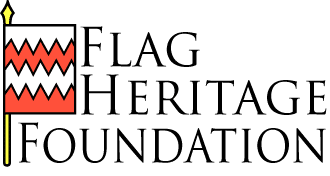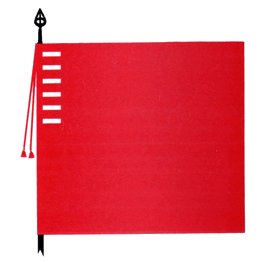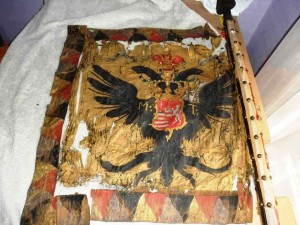The Trustees of the Flag Heritage Foundation note with sorrow the passing on November 17, 2016, of Dr. Whitney Smith, the Foundation’s founding spirit and first and only Director. It was his idea to form the Foundation. He brought it into being and arranged for its endowment, and he supported it with time, energy, ingenuity, expertise, and ideas for 36 years, from its formal establishment in 1971 until he retired as Director in 2007.
The Flag Heritage Foundation was not the only institution Whitney Smith brought into being. He invented the very word vexillology to describe a study that then had no formal coherence, or even a name until he created one. He was the co-convener of the first International Congress of Vexillology (ICV1) in 1965 and co-founder both of the North American Vexillological Association (NAVA) in 1967 and the International Federation of Vexillological Associations (FIAV) in 1969. He was the co-founder and first and only editor of Flag Bulletin, the principal scholarly journal of vexillology, and published 233 issues from 1962 through 2011 (a memorial issue No. 234 can be seen here). He published so many books and articles that there is no reliable count of them – 27 is the number usually given for his books, of which Flags Through the Ages and Around the World (1975) and The Flag Book of the United States (1976) are the best known.
The Flag Research Center he founded in 1962 was in every sense the world center for flag research, and to this end Whitney Smith created in his home in Winchester, Massachusetts, the greatest library in the world on flags and flag documentation. An account by an awed visitor gives a sense of this library, which has been preserved for free use by scholars everywhere at the Briscoe Center for American History at the University of Texas in Austin. Just the finding aids for this still only partly catalogued collection take up 218 closely typed pages.
We remember Whitney Smith as a warm-hearted friend and a deeply committed, generous, thoughtful, careful and passionate scholar. He took a broad view not only of the details of his subject, but of the subject as a whole, and worked tirelessly to secure a place for it among the social sciences. Although he won every honor the world of vexillology could provide, some of which indeed were named after him, he never forgot that he began his lifelong study as an inquiring child, and was determined to make vexillology accessible and inviting to everyone at every level of learning. He was that rare scholar whose love of his subject led him to produce not only books, but institutions to develop and illuminate his chosen field. He will be missed, but never forgotten.









 in April 2014, and is applying the proceeds of the sale to fund the Flag Heritage Fund at the University of Texas. This gift will allow the Flag Research Center’s vast collection of books, pamphlets, files, papers and documentation about flags, their history and meaning to find a permanent home at the Dolph Briscoe Center for American History at the University’s flagship campus in Austin. This collection, assembled over many decades by Dr. Whitney Smith, the foremost scholar in the field, is the greatest of its kind in the world, and we hope and expect that it will form the nucleus of a great public center for study and scholarship.
in April 2014, and is applying the proceeds of the sale to fund the Flag Heritage Fund at the University of Texas. This gift will allow the Flag Research Center’s vast collection of books, pamphlets, files, papers and documentation about flags, their history and meaning to find a permanent home at the Dolph Briscoe Center for American History at the University’s flagship campus in Austin. This collection, assembled over many decades by Dr. Whitney Smith, the foremost scholar in the field, is the greatest of its kind in the world, and we hope and expect that it will form the nucleus of a great public center for study and scholarship.




David Phillips (1944-2020)
We of the Flag Heritage Foundation mourn the passing of David F. Phillips, our Series Editor, fellow Trustee, and friend. David Frank Phillips II (his full name, which he rarely used) was born September 15, 1944. He passed away on March 26, 2020 from a confluence of health issues.
David, for us, had two impressive personas. The first was David as a longtime member of the Board of Trustees. In this role he was a constant initiator. He was always full of proposals to pursue book projects, to make the most of our collections, to find the best professionals to support our work, and in general to lead us forward. He was equally adept as an editor, as a researcher, and as a writer. His sense of organization was consonant with his background in law and librarianship. He worked very smoothly with the others of us on the Board of Trustees, bringing to us project proposals that were so fully developed that our unanimous endorsement was always a formality. Although his first love was heraldry, he drew respect as a scholar in vexillology as well. All his work was to a very high standard. One could see David as a formidable combination of scholar, editor, and administrator.
Those coming to know David only through the Foundation, however, would begin to realize that David’s true scope was much broader, amounting to quite a different persona. “David wins, hands down, the Reader’s Digest prize for ’The World’s Most Unforgettable Person,’” one of his friends remarked on learning of David’s death. His legal career ranged from defender of Timothy Leary to law librarian. His writing led beyond scholarship to poetry, children’s stories, travelogues, essays, biography, and autobiography. Earlier he had been a draft counselor at the time of the Vietnam War, a taxi driver, a typist, a radio and television broadcaster, and an English teacher in Taiwan. He was one of America’s foremost collectors of heraldic books, atlases, first-day covers, and works in sundry other categories. His spiritual explorations were informed by early psychedelic experiences, which led him eventually to Buddhism and veneration of the Hindu god Ganesha. And even this list is merely suggestive of the twists and turns of his personal journey, as recounted in his autobiography.
David will be sorely missed by his family, colleagues, friends, and acquaintances, and in particular by the remaining Trustees of the Flag Heritage Foundation. He leaves siblings Christopher, Adam, and Victoria, as well as a niece and a nephew.
Some life details: David grew up in Manhattan. He graduated from Columbia University in 1968 and the University of Pennsylvania Law School in 1971. In 1974 he added an M.S. from the Columbia School of Library Service, leading later in his career to his contributions as a legal librarian. For many decades he made his home in San Francisco, where he resided at the time of his death.
Publications: David’s own publications include, as author, “Emblems of the Indian States” (2011) and “The Double Eagle” (2014), and as editor and lead contributor, “Japanese Heraldry and Heraldic Flags” (2018). All three appear in the publication series of the Flag Heritage Foundation and are available on Amazon. David was a frequent contributor to the British journal The Heraldic Craftsman and was one of only two writers granted craft membership in the Society of Heraldic Arts, in England. At the time of his death he had completed the manuscript and design for a book about the heraldic work of the Polish-born artist Arthur Szyk. Most recently, he was the editor and compiler of “Psychedelic Refugee,” the memoirs of Rosemary Woodruff Leary (Timothy’s wife), to be published next winter by Inner Traditions.
Web site: David’s website Radbash.com contains his extensive autobiography, a full list of his heraldic and other publications, and his essays on many other topics ranging from Buddhism to how he became entranced by heraldry as a young child. In a way, David considered this website to be a summation of his life and of his incredibly wide-ranging and original thought.
Our heartfelt thanks to David’s brother Christopher Phillips for essential contributions to this narrative of David’s life and work.